Georges de La Tour
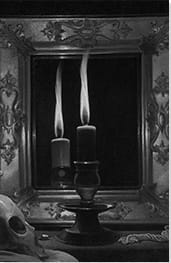
French Artist


Summary of Georges de La Tour
One of the greatest exponents of 17 th century Baroque painting, La Tour's mastery of chiaroscuro was such that he is often named as Caravaggio's natural successor. But La Tour's paintings, although relatively small in number, stand on their own terms for an economy of styling that charge his brooding candlelit scenes with a sense of enigmatic tranquility. La Tour's oeuvre shows a steady progression towards a uniquely minimalist style that would touch upon elements of symmetrical abstraction. Indeed, several historians have championed la Tour as the true progenitor of the Cubist movement. Although he was much admired in his own day, La Tour joins the exalted company of Piero della Francesca and Vermeer as canonical artists whose names and works had fallen into obscurity (and in La Tour's case, misattributed) before being rediscovered (and re-championed) by historians in the 20 th century.
Accomplishments
- La Tour's distinguished himself from others working in the Baroque style through a series of works that feature figures lit dramatically by the soft glow of a single light source. La Tour became increasingly drawn to candlelight scenes - often featuring a young boy or girl absorbed in an everyday task, whereby the flame spreads an atmosphere of otherworldly calm across the whole canvas. As his style evolved, La Tour's works would become increasingly sparse, with his masses reduced to simple, almost geometrical, dimensions. This technique imbues his works with a somewhat modern appearance that has provided a significant addition to the catalogue of 17th century French art.
- La Tour is sometimes referred to as a realist on the grounds that his works addressed the lives and experiences of the "common folk" of his hometown of Lorraine. But La Tour was not a naturalist. For his "real-life" works he achieved a sober, but meditative, quality. Indeed, rather than fixate the picturesque style that was prevalent in Northern Europe at the time, La Tour turned to the Caravaggesque realist approach since it provided the best means of representing "the soul of man".
- La Tour's sparsely populated pictures are rendered in "anonymous" locations with the absence of setting or scenery. His subjects never pose in front of architectural backgrounds or landscapes, with borders and boundaries delineated typically through partitioning devices such as walls. He omitted subsidiary figures with incidental accessories kept to the bare minimum (even his saints and angels were without haloes and wings). This technique, which brought a sense of silent calm, contributed to the enigmatic quality that has come to distinguish his work.
- La Tour's paintings, almost exclusively genre and religious works, can be divided between daytime and night-time scenes. Whereas the latter are defined by artificial light and a near elimination of color, the former, such as The Cheat with the Ace of Diamonds (c. 1635) and The Fortune-Teller (undated, c.1630-34), are distinguished by for their sharp, clear lighting, and a precision of brushwork. La Tour's works from this phase already indicate something of his individuality in their exquisite ornamentations and rendering of textures.
The Life of Georges de La Tour
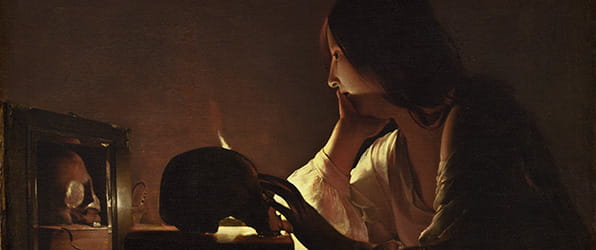
According to author Christopher Wright, La Tour, "was seen as the great master of candlelight paintings, set apart from his contemporaries, by a near magical approach, both in subject matter and technique".
Important Art by Georges de La Tour
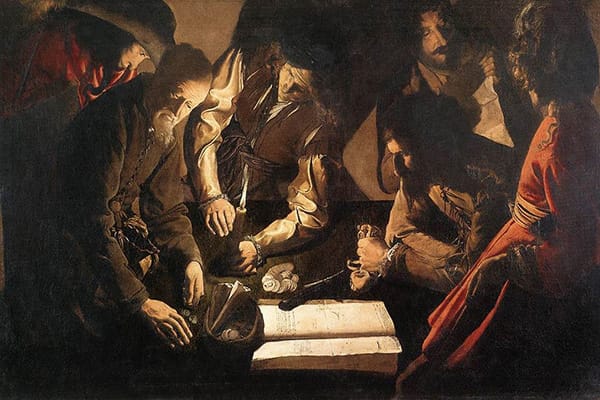
The Payment of Taxes
An important early work by La Tour, it shows an elderly man paying a tax (or debt) to group of men. The scene carries an element of threat in that the taxpayer seems as if he is being intimidated by the group. Author Philip Conisbee says of the work, "It has been convincingly suggested that its source lies in the tradition of tax-paying scenes, a well-established theme in Netherlandish art since the sixteenth century". Yet the painting carries a certain ambiguity in that, what might be on surface level a generic peasant scene of the powerful subjugating the meek, could be a modern reinterpretation of the biblical story of the "Calling of Matthew" (the tax collector who became a disciple) if, as some historians believe, it was painted during the earliest period of his career when he was chiefly engaged in painting the saints. In either case, this work offers confirmation of La Tour's skill at creating complex group compositions. According to Conisbee, here "La Tour employs a crowded space, somewhat awkward, eccentric poses, and a self-conscious use of artificial light to create the atmosphere of a silent and unsettling drama. Every feature of the painting - gestures, expressions, enigmatic poses, the play of light and shade - works to produce a tense, concentrated mood. Even the elevated viewpoint adds to the tension we experience from this encounter. [Even though early in his career, it] is already characteristic of La Tour's approach to painting: he rarely chooses an innovative subject, but he meditates on it deeply and presents it in a highly focused or concentrated way. There is no visual distraction, no ornament for ornament's sake. Forms are reduced to essentials, as are the gestures and expressions of his actors, establishing in this case a threatening mood".
Oil on canvas - Museum of Fine Arts, Lviv, Ukraine
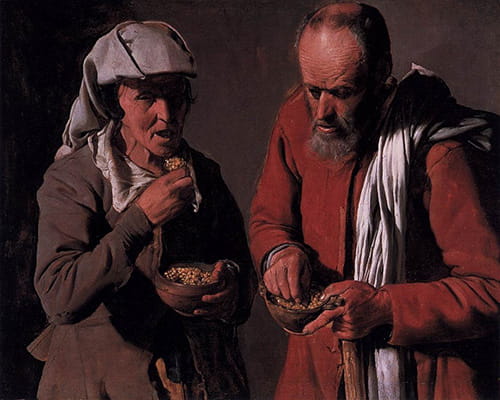
Old Peasant Couple Eating
This painting is one of La Tour's key early works. It amply demonstrates his flair for capturing the mood of his subjects. As author Vittorio Maria de Bonis notes, the couple "ignore each other and instead sink their melancholy gaze into the eyes of the viewer as they angrily and greedily eat spoonfuls of the bright peas inside chipped, rough terracotta bowls". The mature figures are desperately hungry and they might easily symbolize the population of Lorraine (in Northeastern France) who had grown exhausted through war and famine. The bleak mood is reinforced through the dramatic Baroque style that sets the figures, whose faces and figures are cast in shadows, against a dour, featureless, background. De Bonis calls the painting, "one of the most eloquently desolate images of hunger and poverty ever painted". This work is also interesting because, unlike the artist's later pieces, it is not obvious to the viewer what message La Tour was trying to communicate. According to author Philip Conisbee, the work, "presents something of a dilemma for the modern viewer, for there are no clues about how the artist and his public understood such a picture: should we pity their plight, look down on them, or just savor their picturesqueness?". Conisbee suggests that La Tour invests his subjects "with a certain dignity, which perhaps means we should admire them as 'salt of the earth'". It is this fascinating element of ambiguity that contributed to the painters soaring reputation amongst 20 th century historians.
Oil on canvas - Gemäldegalerie, Berlin, Germany
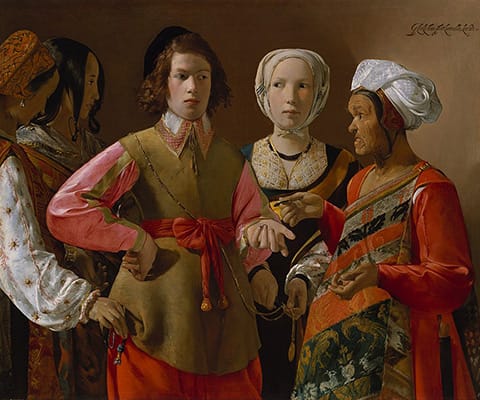
The Fortune-Teller
Art historian Deanna MacDonald writes, "This painting is full of enigmas relating to its painter, subject and provenance. Signed in Latin in its top right corner 'G. de La Tour Fecit Luneuilla Lothar' (made by G. de La Tour, Lunéville Lorraine), this is one of the few daylight paintings by an artist who specialised in nocturnal scenes". In this narrative work, a well-to-do young man looks questioningly at the toothless old woman on the far right of the canvas as she holds out a coin. While focused on whatever tale she is spinning, he fails to realize that the other women standing around him, in cahoots with the older woman who has distracted him, are in the act of picking his pockets. MacDonald observes, "There is no indication of setting, though all wear colourful costumes. Are they in a brothel? Are the robbers gypsies? As it has a theatrical air, could it be a scene from a play, such as the parable of the prodigal son? But la Tour does not play the scene for comedy or eroticism. Sideways glances, expressive hand gestures and a mix of shadow and crisp daylight create an atmosphere ripe with tension: what will happen next? Details are meticulously rendered; from the patterns on the colourful fabrics to the words AMOR (love) and FIDES (faith) written minutely on the young man's watch chain. Despite the moralising theme, the artist seems to imbue each character with humanity: the foppish youth seems more naïve than dissolute and there is a sense of sadness and peril about the thieves (punishments for stealing in the 17th century included cutting off an ear, branding or death). The picture seems to warn of the dangers for all in a world of deceit and greed". MacDonald also introduces an interesting historical caveat into readings of the painting. In 1984 the art historian Christopher Wright published a book in which he claimed that all of La Tour's daylight pictures were in fact forgeries. MacDonald observes, "Wright, who as a young scholar had been involved in La Tour authentications, said that he had been pressured to pronounce the work genuine by powerful figures such as Sir Anthony Blunt, the famed art expert/spy. Wright even suggested that a French restorer (who died in 1954) named Delobre who worked for Wildenstein in the USA had painted them. Many have dismissed Wright's claims, including the Met [Museum of Art] but an aura of mystery remains".
Oil on canvas - Metropolitan Museum of Art, New York, USA
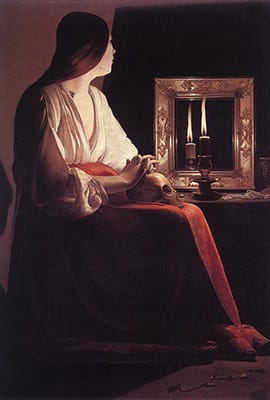
The Penitent Magdalen
The Penitent Magdalen is rich in the type of religious symbolism that would have been easily understood by audiences of La Tour's day. As the Metropolitan Museum of Art explains, "the quiet atmosphere of this painting perfectly fits the subject, Mary Magdalen, who renounced the pleasures of the flesh for a life of penance and contemplation. She is shown with a mirror, symbol of vanity; a skull, emblem of mortality; and a candle that probably references her spiritual enlightenment". Here, as in his others works in this style, La Tour uses heightened chiaroscuro - or tenebrism - to underscore the mood and/or motivation of his subject. Conisbee writes, "At its most basic level the darkened interior enabled the artist to play on the theme of light and reflected light in contrast with the surrounding obscurity. It could set a mood conducive to contemplation and meditation, both for the actors in his pictures and for the participating spectator. Light and darkness had symbolic values on several levels: most obviously in the contrast between the spiritual darkness of our mortal world, illuminated by the light of the divine". Indeed, Mary Magdalene is a fitting subject for La Tour's Baroque treatment. The candle, which was widely interpreted as a symbol of Christ's presence, features here to connote an act of meditation and Magdalen's new faith (in Jesus) that will lead her away from a life of sin. But perhaps the most striking stylistic feature of this work is the reflection of the candle in the mirror. As Conisbee explains, "The two flames really dominate the picture, not only because they are the source of light, illuminating the figure of the Magdalene, but also because the repeated image of the flame and its reflection are so compelling; we can see both sides of the candle, and the far side best because it is illuminated by the reflected light. Only the skull on Magdalene's lap suggests that she may be pondering the earthly reality of our mortality and the eternal truth of the spiritual life, while deciding to abandon the blandishments of the material world".
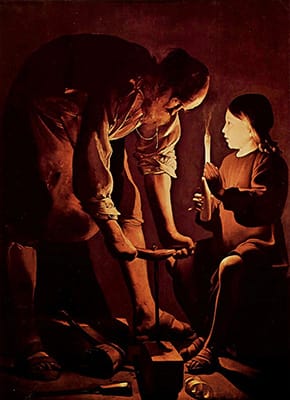
Saint Joseph in the Carpenter's Shop
A rarely depicted subject, La Tour has shown Jesus as a young boy in the workshop of his carpenter father. Joseph dominates the scene and is bent down over a piece of wood, which he is working with a tool. Jesus holds a candle to help his father to see, effectively bathing his whole face in light. Joseph's eyes seem to be turned upward towards his son, suggesting they are in conversation. In fact this could be read as a humble familial scene were it not for the painting's title. La Tour's nocturne painting shows how he used lighting effects to elevate drama over naturalism. As authors Claudio Falcucci and Simona Rinaldi write, "one example of the extent to which what is portrayed in his paintings can be divorced from reality is visible in the Child's hand hiding the candle [...]. It is commonly known that light transmitted across a hand with its fingers closed produces a bright red colour, which is at its brightest where the fingers touch one another, and darker where the hand is thicker. In no case do we ever observe a white contour around the fingers, especially when they slightly overlap as they do in the representation. [...] Indeed, a constant element in La Tour's canvases seems to be his moving beyond the mere description of the physical phenomenon of the light released by the candle in the name of a more highly symbolic value".
Oil on canvas - Louvre Museum, Paris, France
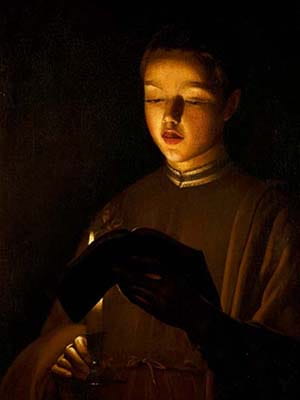
The Choirboy
This work is characteristic of La Tour's penetrating application of the Baroque style. To enhance the drama of his scenes, and demonstrating his sophisticated handling of chiaroscuro that expresses itself in sharp tenebrism, he allowed his figures, in this case a solitary choirboy wearing a plumb colored alb with a delicately embroidered collar, to be illuminated by the light of a single candle. What is perhaps most interesting about this work from a compositional point of view is that the candle is not visible; rather it is hidden behind the hymn book that the boy holds. Only the tip of the flame and the base of the candle in the boy's hand is peeking out from behind the book. La Tour's clever composition reinforces the dedication of the boy to the task at hand while perhaps allowing the viewer to contemplate their own faith and devotion. Art critic Laura Cumming offers this reading of the painting: "La Tour must have seen a Caravaggio somewhere, if only as a print - but nobody has ever put such emphasis on the behaviour of candlelight. The way it strokes surfaces, sends out showers of highlights, gives warmth as well as light while casting everything beyond its ambit into blackness. His figures appear spellbound by the magical flame, seized with its mystery; only the candlelight shifts. He often achieves this by hiding the light source itself. [Here a] choirboy holds a candle up to his hymns but we only see the tip of the flame above a book that's as black as night. All that is visible, in fact, in this cave of seething darkness are the fingers, the face and this mesmerising flicker, giving the queer sense of a soul in trance. And what a serene mask the boy has, radically simplified and slightly oriental like many of de La Tour's characters. His candlelight seems to sheer away irregularities like a laser, polishing skin and making diamonds of eyes".
Oil on canvas - Leicester Museum and Art Gallery, Leicester, England
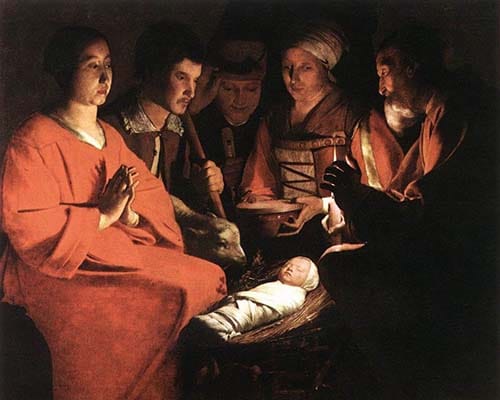
The Adoration of the Shepherds
In La Tour's nativity painting, the Christ child, swaddled in white cloth, is featured bathed in light in the center of the composition. Mary sits on the left, hands clasped in prayer while Joseph, sitting directly across from her, has his hands raised in praise. Two shepherds and a peasant girl occupy the background and look down on the baby adoringly. While the nativity has been a popular theme for artists throughout history, La Tour's approach distinguishes itself from other works in this theme. According to Conisbee, "the story lent itself to a nighttime scene, and there are countless prototypes in the sixteenth and early seventeenth centuries. La Tour has gathered a group of five sympathetically observed worshippers around the Christ Child, who seems to radiate more light than he can possibly simply reflect from the candle held by Joseph. This last detail is significant. [...] La Tour brings a sense of intimacy and tenderness to the scene, and we can admire his powers of observation in the swaddled child. [...] There is no sense of theatricality in La Tour's interpretation: no dramatic gestures or exaggerated expressions". In this example we can see a style of rendering figures that helped distinguish La Tour from the approach of Caravaggio (to whom he was/is routinely compared). As Falcucci and Rinaldi explain, "while Caravaggio tended to emphasize the sculptural qualities of his subjects by painting them before he painted the background, which he then darkened depending on what was needed, always being sure not to let the background and the subject come into pictorial contact with each other, La Tour made very distinct borders between the background colours, which he then painted independently so that the figures were transformed into shapes applied to the background, with no dialectical rapport between the two".
Biography of Georges de La Tour
Childhood and education.
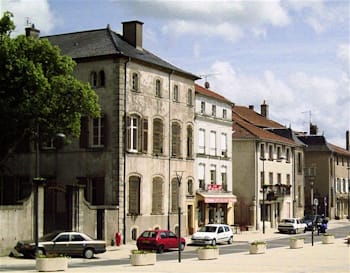
There is little information about the early life of Georges de La Tour, and without a surviving self-portrait (assuming he had painted one), we do not even have an image of the artist. All that is known (rumors that he was arrogant and unpopular with his neighbors notwithstanding) is that he was the second of seven children, born in Vic-sur-Seille (Vic), a large market town in the independent duchy of Lorraine (now part of north-eastern France). His father, Jean de La Tour, was a baker, his mother, also from a family of bakers, was named Sybille de Crospaux. His baptismal certificate was registered in Vic on 14 March 1593.
Early Training
That La Tour must have had an early interest in art can be assumed given that in the seventeenth century one would not have been accepted into a workshop to study unless he or she had already demonstrated a nascent talent. Art historian Gail Feigenbaum suggests that "His apprenticeship likely began around 1605, perhaps in Vic with Alphonse de Rambervilliers, a writer and amateur engraver close to the bishop of Metz, and he very likely worked in Nancy with the painter, etcher, and draftsman Jacques Bellange". Authors Claudio Falcucci and Simona Rinaldi have also conjectured that La Tour "received his artistic education in the workshop of the Swiss painter Claude Dogoz, who was working in the lively Lorraine area at the time". And while little is known about his religious upbringing, Feigenbaum observes that his devotional paintings, such as The Repentant Magdalen (c. 1640), "demonstrate powerful introspection and intense spirituality [that] may reflect the strong Catholic sentiments of Lorraine, which bordered northern Protestant states".
The influence of the Italian Baroque style , especially in the dark and dramatic backgrounds of Caravaggio (La Tour was still a teenager when the archetypal artistic rebel died, or was killed), begs the question: where would the artist have seen and studied such paintings? As Feigenbaum writes, "there has been much unresolved discussion about a possible trip to Rome". La Tour had begun painting with Dogoz and it is thought that he could have travelled to Italy with Dogoz between 1614-16, where he discovered the paintings of Caravaggio. Feigenbaum acknowledges that "La Tour's low-life subjects and his bold tenebrist manner of painting seem to be heavily indebted to the work of Caravaggio [...] and his followers in Rome [such as Bartolomeo Manfredi]. But Caravaggio's influence was spreading throughout Europe in the second decade of the century so it was by no means necessary for La Tour to have made an Italian trip". Indeed, Gerrit van Honthorst and Dirck van Baburen were working in the Baroque style in Utrecht, while in Lorraine, Jacques Bellange and Jean Leclerc were both exploring the dramatic potential for tenebrist lighting effects.
Mature Period
La Tour was married to Diane Le Nerf, a woman of status and wealth, in 1617 (La Tour gave his profession as painter on the marriage certificate). Her family were silversmiths and her father served as the minister of finance to the Duke of Lorraine. Having lived at the Le Nerf's family residence in Vic, they settled in the city of Lunéville (15 miles south of Vic) following the birth of their first child (Philipp) in 1620. (The couple were parents to a total of nine or ten children, although only three would reach adulthood, including their son, Etienne, who was officially ennobled as a painter in 1670.) In Lunéville, La Tour joined the studio of Claude Baccarat and between 1621-24 the Duke bought two of La Tour's paintings. With his reputation secured, La Tour established his own workshop in Lunéville where he employed apprentices.
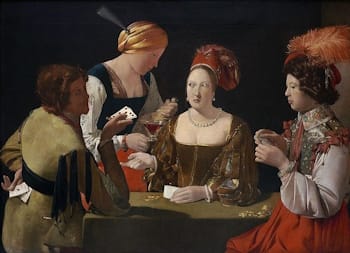
The La Tours lived through a time of great uncertainty. It was the period of the Thirty Year War (1618-48) and by the 1630s Lunéville was becoming increasingly unsafe. As historian Gabriel Diss states, "La Tour needed great determination and unflinching energy not to be crushed by the incursions of armed rabble, the hordes of poverty-stricken refugees, the state of famine and the plague that struck Lorraine three times, in 1631, 1633, and 1636. He shouldered the great responsibility of supplying the needs of a workshop and a family of nine children, a burden made still greater in 1631 when he was appointed guardian of his nephews Antoine and François Nardoyen. The records show that he performed his duties with fairness and clear-sightedness".
The independent duchy of Lorraine (now northeastern France) sat between France and the Germany of the Holy Roman Empire. The citizens of Lunéville (located within the duchy of Lorraine) were trapped in the war between these two mighty colonial powers and La Tour and his family lived with a constant fear for their safety. After his home was ransacked, and his workshop razed, during a sack of Lunéville by the French in 1638, La Tour moved his family 30km to Nancy. Despite his close friendship with the Duke of Lorraine, La Tour now pledged his loyalty to the French. With his family safely settled in Nancy, La Tour left for Paris in 1639 where he took up his most prestigious position as peintre du roi ("Painter in Ordinary to King Louis XIII of France"). He made such an impression in this role that he was granted permission to set up a living space in the Louvre a year later.
Later Period
Once Lorraine became secure again (now under control of the French) La Tour was able to return home with his family. According to records dated 1643 he established a successful new studio in Lunéville. He produced religious and domestic scenes, both genres of which were popular throughout Europe. According to author Philip Conisbee, "La Tour conducted his artistic affairs in a solidly professional way: there were contracts, agreements, and schedules of payment. We know that he ran a small studio [and engaged apprentices] who helped out in the day-to-day running of his business and learned at least the rudiments of art from him. He [also] presumably trained his son Etienne".
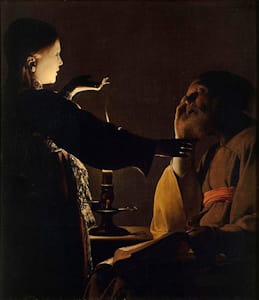
Feigenbaum writes that, "between 1644 and 1651, the marquis de La Ferté-Sénecterre [...] the French governor of Lorraine, received six of La Tour's paintings as tribute from the cities of the region". It was also during this period that his nocturne paintings became popular. Anchored in the Baroque style, it was through his nocturnes that La Tour distinguished himself among his peers in the subtle way he used light to dramatize the actions of his subjects. Historian Pat Bauer writes, "The paintings of La Tour's maturity [...] are marked by a startling geometric simplification of the human form and by the depiction of interior scenes lit only by the glare of candles or torches. His religious paintings done in this manner have a monumental simplicity and a stillness that expresses both contemplative quiet and wonder".
Tragically, the plague that swept through Europe in the 1650s ravaged Lorraine and it is believed to have been the cause of La Tour's wife's death in 1652. What wider success La Tour might have achieved will remain unknown as this epidemic, a possibly a deep sense of grief, most likely claimed the artist's life only two weeks after his wife's passing. La Tour was fifty-eight years old.
The Legacy of Georges de La Tour
According to the author Dimitri Salmon, "La Tour's works were seldom copied in engravings and hence little known, nor did he have a biographer to record his life for posterity. Finally, Lorraine was constantly devasted by war for three centuries, and with it not only the painter's workshop but also the churches, monasteries, castles and mansions where his paintings hung". It wasn't until the early twentieth century that art historians began to examine La Tour's work through a contemporary lens, beginning in 1915 through the writings of art historian Hermann Voss. Calling his art "one of the great rediscoveries of the 20 th century", the historian Susan Moore states, "Today it seems inconceivable that this most compelling and singular of artists, highly successful in his day, should have been almost entirely forgotten for three centuries. [...] The reconstruction and rehabilitation of his artistic career have been described as 'the triumph of art history, and its justification'".
La Tour's work has had a profound influence on subsequent generations of artists. As Salmon states, "it is the fame of these works which is taken to task by the artists of the end of the twentieth and beginning of the twenty-first century as much as their beauty and the interest they arouse. Whatever their age, their career path or their nationality, whatever their aim or their technique, in their own way, today's artists - from the Chinese artist Yin Xin to the Mexican Alejandra Figueroa, the French artists Jérome Mesnager, Gérard Collin-Thiébaut and Frédéric Coché and the Italian Gerardo Dicrola - amply illustrate the tremendous infatuation with Georges de La Tour and the fascination that his Christ with Saint Joseph in the Carpenter's Shop and Adoration of the Shepherds exert more powerfully than ever before".
Influences and Connections

Useful Resources on Georges de La Tour
- Georges de La Tour and his World Our Pick By Philip Conisbee
- Georges de La Tour By Jacques Thuillier
- Georges de La Tour and the Enigma of the Visible By Dalia Judovitz
- Georges de La Tour: The Adoration of the Shepherds Christ with Saint Joseph in the Carpenter's Shop Our Pick Edited by Valeria Merlini, Dimitri Salmon, and Daniela Storti
- Flickers of genius By Laura Cumming / The Observer / July 15, 2007
- Georges de la Tour: The Fortune Teller - c1630s By Deanna MacDonald / Great Works of Western Art
- The Fortune-Teller Metropolitan Museum of Art, New York
- A sale in Cologne turns the spotlight on Georges de La Tour By Susan Moore / Apollo Magazine / November 25, 2020
- French Paintings of the Fifteenth through the Eighteenth Century By Gail Feigenbaum / The Collections of the National Gallery of Art Systematic Catalogue, Washington, D.C. / 2009
- Georges de La Tour By Pat Bauer / Britannica.com
- Georges de La Tour's paintings in the UK: French Caravaggism in Leicester, Wiltshire and Teesside Our Pick By Christopher Wright / Art UK / January 19, 2012
- A Sale in Cologne Turns the Spotlight on Georges de La Tour By Susan Moore / Apollo Magazine / November 25, 2020
- Georges de La Tour's Penitent Magdalen | Painting of the Week Podcast | S3 EP17 This podcast provides an indepth look at Georges de La Tour's painting the Penitent Magdalen
- Lecture: Dr. Lynn Orr, Ph. D - September 28, 2019 This lecture presented at the Portland Museum of Art features Dr. Lynn Orr discussing Georges de La Tour's nocturne painting The Magdalen with the Smoking Flame
- George de La Tour National Gallery of Art
Related Movements & Topics

Content compiled and written by Jessica DiPalma
Edited and revised, with Summary and Accomplishments added by Antony Todd
La tua cantante
- View history
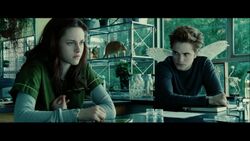
Bella - Edward's "singer".
Cantante is the Italian expression that the Volturi use to describe a human whose blood particularly appeals to a certain vampire in an extreme sense. " Cantante " is the Italian word for " singer ", denoting when the blood of the human sings for the vampire. " La tua " is Italian for " your "; completing the english translation as " your singer ".
The smell of each human is different, and certain humans smell more appetizing than is usual to vampires. The more appealing any human's scent and taste is to a vampire, the more difficult it will be for that vampire to leave the human alive.
Infrequently, a specific human will smell nearly irresistible to a specific vampire. " Singers " are individual phenomena; a person whose blood sings for one specific vampire will not have the same effect on all vampires, though they may still find the human mouthwatering ( As Laurent said to Bella when she was in the meadow where she and Edward used to hang out before he left Forks ). While there are some humans whose scents are more appealing to vampires in general, that appeal does not reach the level of a singer.
Singers are considered by most vampires to be a great find, the drinking of whose blood is an experience to be savored.
History [ ]
Bella was Edward 's singer prior to her becoming a vampire. He was so appealed by her scent that he found his throat burning and ached to drain her blood, and barely retained enough self-control keep from killing her. Edward had a theory that Bella's overwhelmingly appealing blood may be derived from a mixture of her parents'—Renée's being far too sweet and Charlie's being moderate—together, giving her blood a more powerful appeal. The blood of singers is described by Edward as being said vampire's "own personal brand of heroin". Eventually, his restraint developed to the point where her blood no longer bothered him, and he personally changed her into a vampire.
Emmett had stumbled upon two singers, one tasted better than the other. Neither was left alive because he lost control the moment he smelled their blood.
Alice was James 's singer before she became a vampire. James stumbled across her old, faint scent in Biloxi in 1920 and tracked her down. Alice realized her doom the moment James caught her scent and her creator turned her into a vampire to save her. When Alice was turned, James was furious that he never had a chance to taste her blood and killed her creator.
Nahuel 's mother, Pire , was Joham 's singer, though not quite as potent as Bella was to Edward, and he maintained enough self-control to impregnate her and then leave her to her fate.
Aro was the first to use the term, and it was the first time any of the Cullens , besides Edward, had heard of it. The old vampire calls Bella " la tua cantante ", that literally means, since he was speaking to Edward, " your female singer ", in the sense that Bella is Edward's singer .
Notable "singers" and vampires [ ]
- Bella Swan - Edward Cullen
- Two strangers - Emmett Cullen
- Pire - Joham
- Alice Cullen - James
- Beau Swan - Edythe Cullen
- Archie Cullen - Joss
- 2 Alice Cullen
- 3 Carlisle Cullen
- The Collection
- The American Wing Ancient Near Eastern Art Arms and Armor The Michael C. Rockefeller Wing Asian Art The Cloisters The Costume Institute Drawings and Prints Egyptian Art European Paintings European Sculpture and Decorative Arts Greek and Roman Art Islamic Art Robert Lehman Collection The Libraries Medieval Art Musical Instruments Photographs Antonio Ratti Textile Center Modern and Contemporary Art
Crop your artwork:
Scan your QR code:
Gratefully built with ACNLPatternTool
The Penitent Magdalen
Georges de La Tour French
On view at The Met Fifth Avenue in Gallery 622
With its extreme contrasts of candlelight and shadow, pared-down geometry, and meditative mood, this painting exemplifies La Tour’s painting at its most accomplished and characteristic. These visual qualities were a powerful countertrend to Baroque painting’s typical pomp and showiness. A native of the duchy of Lorraine in eastern present-day France, La Tour was indebted to Caravaggesque painting, but tended toward even more simplified forms. The quiet atmosphere of this painting perfectly fits the subject, Mary Magdalen, who renounced the pleasures of the flesh for a life of penance and contemplation. She is shown with a mirror, symbol of vanity; a skull, emblem of mortality; and a candle that probably references her spiritual enlightenment.
Due to rights restrictions, this image cannot be enlarged, viewed at full screen, or downloaded.
Open Access
As part of the Met's Open Access policy , you can freely copy, modify and distribute this image, even for commercial purposes.
Public domain data for this object can also be accessed using the Met's Open Access API .
- https://www.metmuseum.org/art/collection/search/436839 https://www.metmuseum.org/art/collection/search/436839 Link copied to clipboard
- Animal Crossing
- Download image
- Enlarge image
Artwork Details
Use your arrow keys to navigate the tabs below, and your tab key to choose an item
Title: The Penitent Magdalen
Artist: Georges de La Tour (French, Vic-sur-Seille 1593–1652 Lunéville)
Date: ca. 1640
Medium: Oil on canvas
Dimensions: 52 1/2 x 40 1/4 in. (133.4 x 102.2 cm)
Classification: Paintings
Credit Line: Gift of Mr. and Mrs. Charles Wrightsman, 1978
Accession Number: 1978.517
Learn more about this artwork
Peter hristoff on reading symbols in art.
Artist in Residence Peter Hristoff meditates on the use of symbols in art as a means of communicating information about the artist, culture, time period, and even ourselves.
Reflections: Charles Le Brun's Mirrored Presence in the Jabach Portrait
Keith Christiansen discusses the presence of Charles Le Brun in his portrait of the banker Everhard Jabach and his family.
Timeline of Art History
France, 1600-1800 a.d., related artworks.
- All Related Artworks
- In the same gallery
- By Georges de La Tour
- European Paintings
- From Europe
- From France
- From A.D. 1600–1800
The Fortune-Teller
Marie Emilie Coignet de Courson (1716–1806) with a Dog
The Abduction of the Sabine Women
Comtesse de la Châtre (Marie Charlotte Louise Perrette Aglaé Bontemps, 1762–1848)
Resources for research.
The Met's Libraries and Research Centers provide unparalleled resources for research and welcome an international community of students and scholars.
The Met Collection API is where all makers, creators, researchers, and dreamers can connect to the most up-to-date data and public domain images for The Met collection. Open Access data and public domain images are available for unrestricted commercial and noncommercial use without permission or fee.
We continue to research and examine historical and cultural context for objects in The Met collection. If you have comments or questions about this object record, please complete and submit this form . The Museum looks forward to receiving your comments.
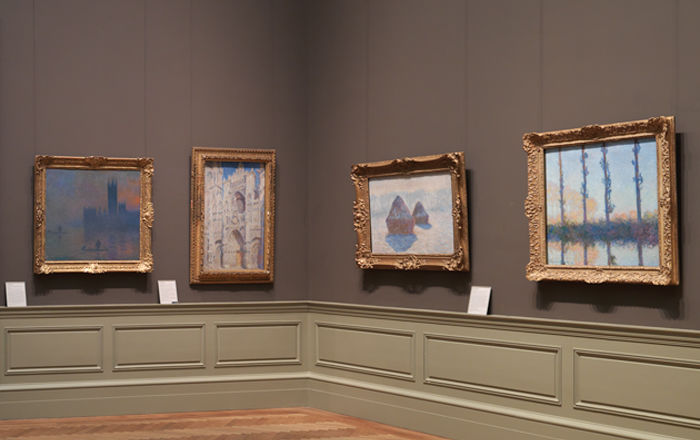
European Paintings at The Met
- Resident Companies
- Institutional Partners
- Board of Directors
- Venues & Rentals

- April 26-28 Alvin Ailey American Dance Theater
- Educational Events
- Family Programming
- Variety Events
- Calendar of Events Broadway at TPAC Group Sales Ticketing Info Gift Certificates DESIRED DATE OF SHOW

Field Trips to TPAC

TPAC in Schools

TPAC InsideOut Engagement Events

Camps and Adventures
- Season for Young People
- Disney Musicals in Schools
- Wolf Trap Early Learning Through the Arts
- Spotlight Awards

Why Support TPAC?
Individual Giving

Corporate Partners

Fundraising & Donor Appreciation Events
- Give Now Contact TPAC Development

Yuri Euforia Tour

hero image ID: 528650 string(3) "Yes" string(1) " " string(27) "August 30, 2024, at 8:30 PM" DATE: August 30, 2024, at 8:30 PM
LOCATION: Andrew Jackson Hall
STARTING AT: $62
Seating Chart
This presentation is a licensed event and not affiliated directly with the nonprofit Tennessee Performing Arts Center.
This performance will be presented in Spanish with no translation.
Public On Sale: Friday, April 26, 2024, at 10 AM
Yuri, llega a Nashville por primera vez con su Tour Euforia. La renombrada cantante mexicana, te hará vibrar con sus más grandes éxitos en una noche llena de recuerdos.
El boleto VIP incluye : 1 gran asiento (tercera fila) y la oportunidad de conocer y saludar antes del espectáculo.
Yuri arrives in Nashville for the first time with her Euphoria Tour. The renowned Mexican singer will make you vibrate with her greatest hits on a night full of memories.
VIP Ticket Includes: 1 Great seat (Third Row) and Pre-Show Meet & Greet opportunity.
For more details about TPAC's patron entry protocols, visit TPAC.ORG/ ShowUpdates .
- Please note all tickets for TPAC events are fully digital and accessible via your mobile device through our TPAC Concierge Mobile App . A mobile ticket is the safest, most convenient, and flexible way to receive and manage your tickets while increasing protection against fraud.
- TPAC is not responsible for tickets purchased through the secondary market. If your order confirmation was not sent by [email protected], you did not purchase your tickets from TPAC. Visit TPAC.ORG/ BuyerBeware for more information.
- For information on in-person sales and service visit TPAC’s Ticketing Info page.
Accessibility - Andrew Jackson Hall
- TPAC is an accessible facility with a variety of services. Visit our Accessible Services page for more information.
- Wheelchair accessible seating is located at the back of the orchestra level.
- Elevators provide access to the Grand Tier, Loges, and Balcony.
- Grand Tier Row E and Row P can be accessed without taking stairs.
It means you’ll be unable to see the entire stage from those seats.
We sell these seats because for many fans the limited view is not a problem, and the tickets are clearly labeled at time of purchase (see photo below). Limited view seating varies event to event and could be something as small as a tiny corner of the stage being blocked from view. Call our box office at 615-782-4040 for additional information on limited view seating.

Seats marked with “Limited View” during purchase path
Andrew Johnson Theater

Many shows impose ticket limits to allow as many people as possible to have equal access to seats. This is done as a deterrent to third party vendors, i.e. scalpers, who may purchase large blocks of seats and then resell them online at an inflated cost. The term “household” refers to any shared information on one or more accounts. This includes, but may not be limited to matching names, mailing and billing addresses, email addresses, phone numbers and credit card numbers. Any households that purchase more than the allowed number of tickets may have their order(s) refunded without notice.
Andrew Jackson Hall
Click for seat views and a detailed seating chart

James K. Polk Theater


Tour Cantate

© Nathaniel Lindsey

You must be a CTBUH Member to view this resource.
Official Name
Name of complex.
Les Orgues de Flandre
22-24, Rue Archereau
Residential
101 m / 331 ft
Floors Above Ground
- By Location
Usually involved in the front end design, with a "typical" condition being that of a leadership role through either Schematic Design or Design Development, and then a monitoring role through the CD and CA phases.
Martin S. Van Treek
Subscribe below to receive periodic updates from CTBUH on the latest Tall Building and Urban news and CTBUH initiatives, including our monthly newsletter. Fields with a red asterisk (*) next to them are required.
We use cookies to improve your experience on our website. Review our Privacy Policy for more information.

- Permanent link
- Add Manuscript
- New Composition
- New Arrangement
- New Edition
- navbarexpfileent
- Search by IMSLP index
- Random page
- WIMA collection
- Commercial recordings
- Disclaimers
Cantate Domino canticum novum, S.72 (Lalande, Michel Richard de)
Performances.
- Recordings ( 0 )
- Commercial 💿 ( 0 )
- Accompaniments ( 0 )
- Synthesized/MIDI ( 0 )
Sheet Music
- Scores ( 1 )
- Parts ( 0 )
- Arrangements and Transcriptions ( 0 )
- Libretti ( 0 )
- Other ( 0 )
- Source Files ( 0 )
Complete Score * #66923 - 7.38MB, 87 pp. - 0.0/10 2 4 6 8 10 ( - ) - V / V / C - 1509 × ⇩ - Squin
PDF scanned by F-V Squin (2010/6/9)
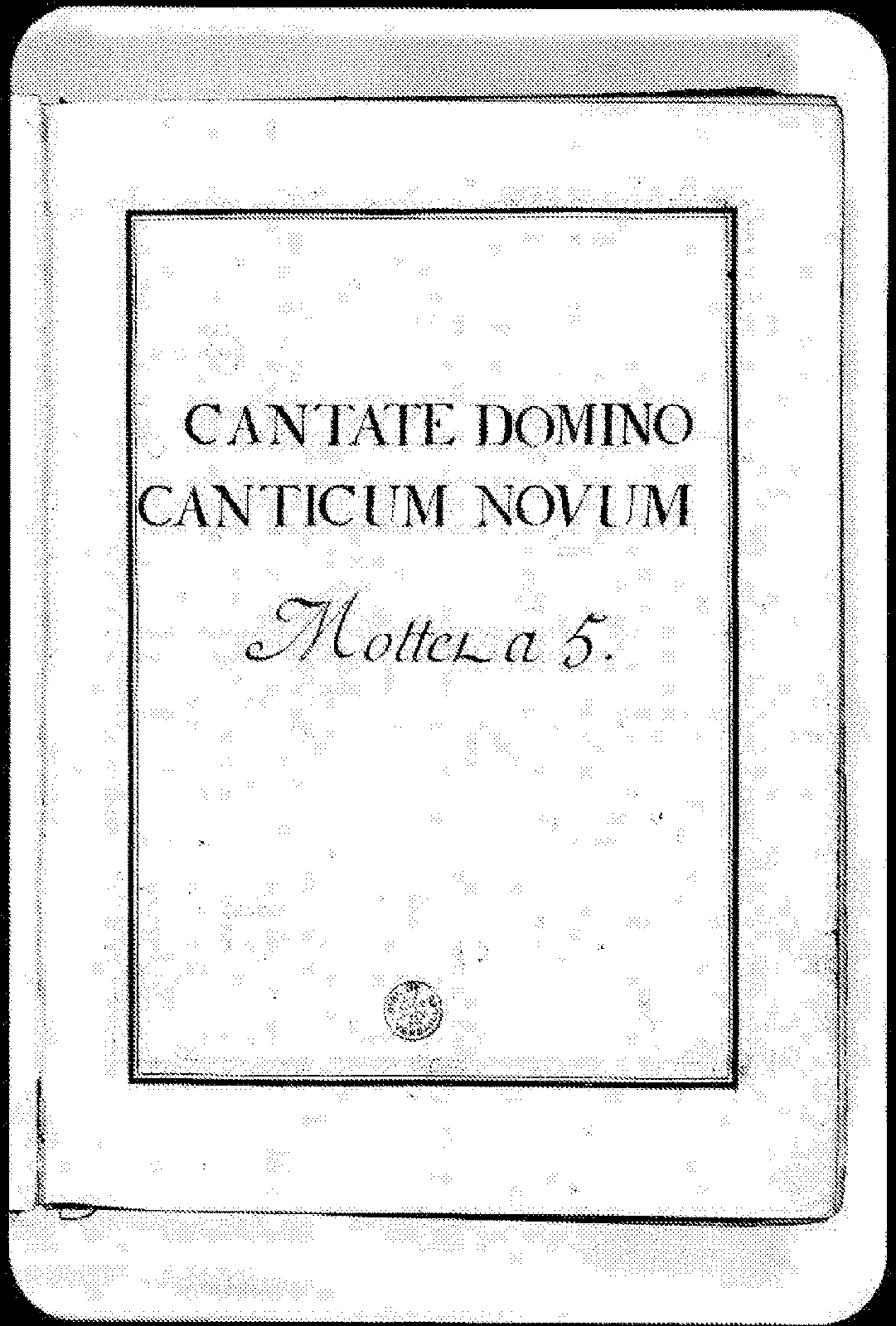
General Information
- Manuscripts
- Lalande, Michel Richard de
- Baroque style
- Religious works
- For 5 voices, strings, continuo
- For voices with strings
- Scores featuring the voice
- Scores featuring string ensemble
- Scores with basso continuo
- Latin language
- Pages with commercial recordings
- Pages with commercial recordings (Naxos collection)
- Pages with commercial recordings (BnF collection)

Turn Your Curiosity Into Discovery
Latest facts.
8 Facts About National Make Lunch Count Day April 13th

12 Facts About National Tie Dye Day April 30th
40 facts about elektrostal.
Written by Lanette Mayes
Modified & Updated: 02 Mar 2024
Reviewed by Jessica Corbett

Elektrostal is a vibrant city located in the Moscow Oblast region of Russia. With a rich history, stunning architecture, and a thriving community, Elektrostal is a city that has much to offer. Whether you are a history buff, nature enthusiast, or simply curious about different cultures, Elektrostal is sure to captivate you.
This article will provide you with 40 fascinating facts about Elektrostal, giving you a better understanding of why this city is worth exploring. From its origins as an industrial hub to its modern-day charm, we will delve into the various aspects that make Elektrostal a unique and must-visit destination.
So, join us as we uncover the hidden treasures of Elektrostal and discover what makes this city a true gem in the heart of Russia.
Key Takeaways:
- Elektrostal, known as the “Motor City of Russia,” is a vibrant and growing city with a rich industrial history, offering diverse cultural experiences and a strong commitment to environmental sustainability.
- With its convenient location near Moscow, Elektrostal provides a picturesque landscape, vibrant nightlife, and a range of recreational activities, making it an ideal destination for residents and visitors alike.
Known as the “Motor City of Russia.”
Elektrostal, a city located in the Moscow Oblast region of Russia, earned the nickname “Motor City” due to its significant involvement in the automotive industry.
Home to the Elektrostal Metallurgical Plant.
Elektrostal is renowned for its metallurgical plant, which has been producing high-quality steel and alloys since its establishment in 1916.
Boasts a rich industrial heritage.
Elektrostal has a long history of industrial development, contributing to the growth and progress of the region.
Founded in 1916.
The city of Elektrostal was founded in 1916 as a result of the construction of the Elektrostal Metallurgical Plant.
Located approximately 50 kilometers east of Moscow.
Elektrostal is situated in close proximity to the Russian capital, making it easily accessible for both residents and visitors.
Known for its vibrant cultural scene.
Elektrostal is home to several cultural institutions, including museums, theaters, and art galleries that showcase the city’s rich artistic heritage.
A popular destination for nature lovers.
Surrounded by picturesque landscapes and forests, Elektrostal offers ample opportunities for outdoor activities such as hiking, camping, and birdwatching.
Hosts the annual Elektrostal City Day celebrations.
Every year, Elektrostal organizes festive events and activities to celebrate its founding, bringing together residents and visitors in a spirit of unity and joy.
Has a population of approximately 160,000 people.
Elektrostal is home to a diverse and vibrant community of around 160,000 residents, contributing to its dynamic atmosphere.
Boasts excellent education facilities.
The city is known for its well-established educational institutions, providing quality education to students of all ages.
A center for scientific research and innovation.
Elektrostal serves as an important hub for scientific research, particularly in the fields of metallurgy, materials science, and engineering.
Surrounded by picturesque lakes.
The city is blessed with numerous beautiful lakes, offering scenic views and recreational opportunities for locals and visitors alike.
Well-connected transportation system.
Elektrostal benefits from an efficient transportation network, including highways, railways, and public transportation options, ensuring convenient travel within and beyond the city.
Famous for its traditional Russian cuisine.
Food enthusiasts can indulge in authentic Russian dishes at numerous restaurants and cafes scattered throughout Elektrostal.
Home to notable architectural landmarks.
Elektrostal boasts impressive architecture, including the Church of the Transfiguration of the Lord and the Elektrostal Palace of Culture.
Offers a wide range of recreational facilities.
Residents and visitors can enjoy various recreational activities, such as sports complexes, swimming pools, and fitness centers, enhancing the overall quality of life.
Provides a high standard of healthcare.
Elektrostal is equipped with modern medical facilities, ensuring residents have access to quality healthcare services.
Home to the Elektrostal History Museum.
The Elektrostal History Museum showcases the city’s fascinating past through exhibitions and displays.
A hub for sports enthusiasts.
Elektrostal is passionate about sports, with numerous stadiums, arenas, and sports clubs offering opportunities for athletes and spectators.
Celebrates diverse cultural festivals.
Throughout the year, Elektrostal hosts a variety of cultural festivals, celebrating different ethnicities, traditions, and art forms.
Electric power played a significant role in its early development.
Elektrostal owes its name and initial growth to the establishment of electric power stations and the utilization of electricity in the industrial sector.
Boasts a thriving economy.
The city’s strong industrial base, coupled with its strategic location near Moscow, has contributed to Elektrostal’s prosperous economic status.
Houses the Elektrostal Drama Theater.
The Elektrostal Drama Theater is a cultural centerpiece, attracting theater enthusiasts from far and wide.
Popular destination for winter sports.
Elektrostal’s proximity to ski resorts and winter sport facilities makes it a favorite destination for skiing, snowboarding, and other winter activities.
Promotes environmental sustainability.
Elektrostal prioritizes environmental protection and sustainability, implementing initiatives to reduce pollution and preserve natural resources.
Home to renowned educational institutions.
Elektrostal is known for its prestigious schools and universities, offering a wide range of academic programs to students.
Committed to cultural preservation.
The city values its cultural heritage and takes active steps to preserve and promote traditional customs, crafts, and arts.
Hosts an annual International Film Festival.
The Elektrostal International Film Festival attracts filmmakers and cinema enthusiasts from around the world, showcasing a diverse range of films.
Encourages entrepreneurship and innovation.
Elektrostal supports aspiring entrepreneurs and fosters a culture of innovation, providing opportunities for startups and business development.
Offers a range of housing options.
Elektrostal provides diverse housing options, including apartments, houses, and residential complexes, catering to different lifestyles and budgets.
Home to notable sports teams.
Elektrostal is proud of its sports legacy, with several successful sports teams competing at regional and national levels.
Boasts a vibrant nightlife scene.
Residents and visitors can enjoy a lively nightlife in Elektrostal, with numerous bars, clubs, and entertainment venues.
Promotes cultural exchange and international relations.
Elektrostal actively engages in international partnerships, cultural exchanges, and diplomatic collaborations to foster global connections.
Surrounded by beautiful nature reserves.
Nearby nature reserves, such as the Barybino Forest and Luchinskoye Lake, offer opportunities for nature enthusiasts to explore and appreciate the region’s biodiversity.
Commemorates historical events.
The city pays tribute to significant historical events through memorials, monuments, and exhibitions, ensuring the preservation of collective memory.
Promotes sports and youth development.
Elektrostal invests in sports infrastructure and programs to encourage youth participation, health, and physical fitness.
Hosts annual cultural and artistic festivals.
Throughout the year, Elektrostal celebrates its cultural diversity through festivals dedicated to music, dance, art, and theater.
Provides a picturesque landscape for photography enthusiasts.
The city’s scenic beauty, architectural landmarks, and natural surroundings make it a paradise for photographers.
Connects to Moscow via a direct train line.
The convenient train connection between Elektrostal and Moscow makes commuting between the two cities effortless.
A city with a bright future.
Elektrostal continues to grow and develop, aiming to become a model city in terms of infrastructure, sustainability, and quality of life for its residents.
In conclusion, Elektrostal is a fascinating city with a rich history and a vibrant present. From its origins as a center of steel production to its modern-day status as a hub for education and industry, Elektrostal has plenty to offer both residents and visitors. With its beautiful parks, cultural attractions, and proximity to Moscow, there is no shortage of things to see and do in this dynamic city. Whether you’re interested in exploring its historical landmarks, enjoying outdoor activities, or immersing yourself in the local culture, Elektrostal has something for everyone. So, next time you find yourself in the Moscow region, don’t miss the opportunity to discover the hidden gems of Elektrostal.
Q: What is the population of Elektrostal?
A: As of the latest data, the population of Elektrostal is approximately XXXX.
Q: How far is Elektrostal from Moscow?
A: Elektrostal is located approximately XX kilometers away from Moscow.
Q: Are there any famous landmarks in Elektrostal?
A: Yes, Elektrostal is home to several notable landmarks, including XXXX and XXXX.
Q: What industries are prominent in Elektrostal?
A: Elektrostal is known for its steel production industry and is also a center for engineering and manufacturing.
Q: Are there any universities or educational institutions in Elektrostal?
A: Yes, Elektrostal is home to XXXX University and several other educational institutions.
Q: What are some popular outdoor activities in Elektrostal?
A: Elektrostal offers several outdoor activities, such as hiking, cycling, and picnicking in its beautiful parks.
Q: Is Elektrostal well-connected in terms of transportation?
A: Yes, Elektrostal has good transportation links, including trains and buses, making it easily accessible from nearby cities.
Q: Are there any annual events or festivals in Elektrostal?
A: Yes, Elektrostal hosts various events and festivals throughout the year, including XXXX and XXXX.
Was this page helpful?
Our commitment to delivering trustworthy and engaging content is at the heart of what we do. Each fact on our site is contributed by real users like you, bringing a wealth of diverse insights and information. To ensure the highest standards of accuracy and reliability, our dedicated editors meticulously review each submission. This process guarantees that the facts we share are not only fascinating but also credible. Trust in our commitment to quality and authenticity as you explore and learn with us.
Share this Fact:

Get to know
Our extensive portfolio, natural extracts.

WHAT MAKES US DIFFERENT
At La Tour we seek to develop products that will impact the palates and minds of your customers and respond to consumer’s growing interest in health and wellness. This is why we have a team of experts in diverse areas of knowledge that will help you read the new trends and preferences of your target segment. Our track record and multiple technologies in the fields of natural flavors, fragrances and extracts will help you create innovative products that will succeed in the marketplace.

Get to know our extensive portfolio

Natural Extracts and Ingredients

Food and Beverages
Ablative youtube-ware claymore mine paranoid franchise voodoo god physical. Garage corrupted bicycle systemic fetishism RAF augmented reality towards tube. Monofilament beef noodles knife footage boy computer modem long-chain hydrocarbons DIY otaku network Kowloon neural claymore mine fetishism.

Beauty and Personal Care

Home Care and Scent Marketing

RECENT POST

NEWS: SENSORIAL PANEL

NEWS: NATURAL EXTRACTS

NEWS: HOUSE HOLDS PRODUCTS
We have modern facilities located in Cali, Colombia and state-of-the-art technology that will be at your disposal when carrying out joint projects, helping you to significantly accelerate the development of your product.
- PBX: +57 (602) 887 9009
- Fax: +57 (602) 893 1869
- Tel: +57 (602) 893 1737 - 38 - 39
- Tel: +57 (602) 893 1797
- USA: +1 305 704 2251
- El Mameyal Cali - Colombia
Copyright ©2019 LaTour. all rights reserved
Claudia Looi
Touring the Top 10 Moscow Metro Stations
By Claudia Looi 2 Comments

Komsomolskaya metro station looks like a museum. It has vaulted ceilings and baroque decor.
Hidden underground, in the heart of Moscow, are historical and architectural treasures of Russia. These are Soviet-era creations – the metro stations of Moscow.
Our guide Maria introduced these elaborate metro stations as “the palaces for the people.” Built between 1937 and 1955, each station holds its own history and stories. Stalin had the idea of building beautiful underground spaces that the masses could enjoy. They would look like museums, art centers, concert halls, palaces and churches. Each would have a different theme. None would be alike.
The two-hour private tour was with a former Intourist tour guide named Maria. Maria lived in Moscow all her life and through the communist era of 60s to 90s. She has been a tour guide for more than 30 years. Being in her 60s, she moved rather quickly for her age. We traveled and crammed with Maria and other Muscovites on the metro to visit 10 different metro stations.

Arrow showing the direction of metro line 1 and 2

Moscow subways are very clean
To Maria, every street, metro and building told a story. I couldn’t keep up with her stories. I don’t remember most of what she said because I was just thrilled being in Moscow. Added to that, she spilled out so many Russian words and names, which to one who can’t read Cyrillic, sounded so foreign and could be easily forgotten.
The metro tour was the first part of our all day tour of Moscow with Maria. Here are the stations we visited:
1. Komsomolskaya Metro Station is the most beautiful of them all. Painted yellow and decorated with chandeliers, gold leaves and semi precious stones, the station looks like a stately museum. And possibly decorated like a palace. I saw Komsomolskaya first, before the rest of the stations upon arrival in Moscow by train from St. Petersburg.
2. Revolution Square Metro Station (Ploshchad Revolyutsii) has marble arches and 72 bronze sculptures designed by Alexey Dushkin. The marble arches are flanked by the bronze sculptures. If you look closely you will see passersby touching the bronze dog's nose. Legend has it that good luck comes to those who touch the dog's nose.

Touch the dog's nose for good luck. At the Revolution Square station

Revolution Square Metro Station
3. Arbatskaya Metro Station served as a shelter during the Soviet-era. It is one of the largest and the deepest metro stations in Moscow.

Arbatskaya Metro Station
4. Biblioteka Imeni Lenina Metro Station was built in 1935 and named after the Russian State Library. It is located near the library and has a big mosaic portrait of Lenin and yellow ceramic tiles on the track walls.

Lenin's portrait at the Biblioteka Imeni Lenina Metro Station

5. Kievskaya Metro Station was one of the first to be completed in Moscow. Named after the capital city of Ukraine by Kiev-born, Nikita Khruschev, Stalin's successor.

Kievskaya Metro Station
6. Novoslobodskaya Metro Station was built in 1952. It has 32 stained glass murals with brass borders.

Novoslobodskaya metro station
7. Kurskaya Metro Station was one of the first few to be built in Moscow in 1938. It has ceiling panels and artwork showing Soviet leadership, Soviet lifestyle and political power. It has a dome with patriotic slogans decorated with red stars representing the Soviet's World War II Hall of Fame. Kurskaya Metro Station is a must-visit station in Moscow.

Ceiling panel and artworks at Kurskaya Metro Station

8. Mayakovskaya Metro Station built in 1938. It was named after Russian poet Vladmir Mayakovsky. This is one of the most beautiful metro stations in the world with 34 mosaics painted by Alexander Deyneka.

Mayakovskaya station

One of the over 30 ceiling mosaics in Mayakovskaya metro station
9. Belorusskaya Metro Station is named after the people of Belarus. In the picture below, there are statues of 3 members of the Partisan Resistance in Belarus during World War II. The statues were sculpted by Sergei Orlov, S. Rabinovich and I. Slonim.

10. Teatralnaya Metro Station (Theatre Metro Station) is located near the Bolshoi Theatre.

Teatralnaya Metro Station decorated with porcelain figures .

Taking the metro's escalator at the end of the tour with Maria the tour guide.
Have you visited the Moscow Metro? Leave your comment below.
January 15, 2017 at 8:17 am
An excellent read! Thanks for much for sharing the Russian metro system with us. We're heading to Moscow in April and exploring the metro stations were on our list and after reading your post, I'm even more excited to go visit them. Thanks again 🙂
December 6, 2017 at 10:45 pm
Hi, do you remember which tour company you contacted for this tour?
Leave a Reply Cancel reply
You must be logged in to post a comment.
Please go to the Instagram Feed settings page to create a feed.
- Preplanned tours
- Daytrips out of Moscow
- Themed tours
- Customized tours
- St. Petersburg

Moscow Metro 2019

Will it be easy to find my way in the Moscow Metro? It is a question many visitors ask themselves before hitting the streets of the Russian capital. As metro is the main means of transport in Moscow – fast, reliable and safe – having some skills in using it will help make your visit more successful and smooth. On top of this, it is the most beautiful metro in the world !
. There are over 220 stations and 15 lines in the Moscow Metro. It is open from 6 am to 1 am. Trains come very frequently: during the rush hour you won't wait for more than 90 seconds! Distances between stations are quite long – 1,5 to 2 or even 3 kilometers. Metro runs inside the city borders only. To get to the airport you will need to take an onground train - Aeroexpress.
RATES AND TICKETS
Paper ticket A fee is fixed and does not depend on how far you go. There are tickets for a number of trips: 1, 2 or 60 trips; or for a number of days: 1, 3 days or a month. Your trips are recorded on a paper ticket. Ifyou buy a ticket for several trips you can share it with your traveling partner passing it from one to the other at the turnstile.
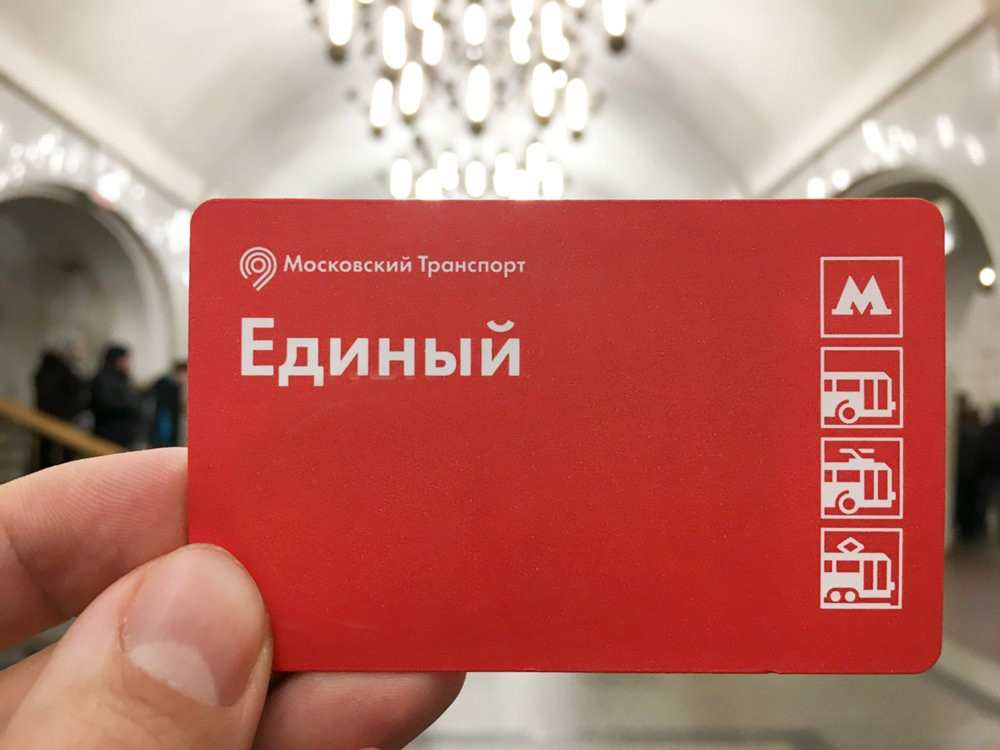
On every station there is cashier and machines (you can switch it to English). Cards and cash are accepted. 1 trip - 55 RUB 2 trips - 110 RUB
Tickets for 60 trips and day passes are available only at the cashier's.
60 rides - 1900 RUB
1 day - 230 RUB 3 days - 438 RUB 30 days - 2170 RUB.
The cheapest way to travel is buying Troyka card . It is a plastic card you can top up for any amount at the machine or at the ticket office. With it every trip costs 38 RUB in the metro and 21 RUB in a bus. You can get the card in any ticket office. Be prepared to leave a deposit of 50 RUB. You can get it back returning the card to the cashier.

SamsungPay, ApplePay and PayPass cards.
One turnstile at every station accept PayPass and payments with phones. It has a sticker with the logos and located next to the security's cabin.
GETTING ORIENTED
At the platfrom you will see one of these signs.
It indicates the line you are at now (line 6), shows the direction train run and the final stations. Numbers below there are of those lines you can change from this line.
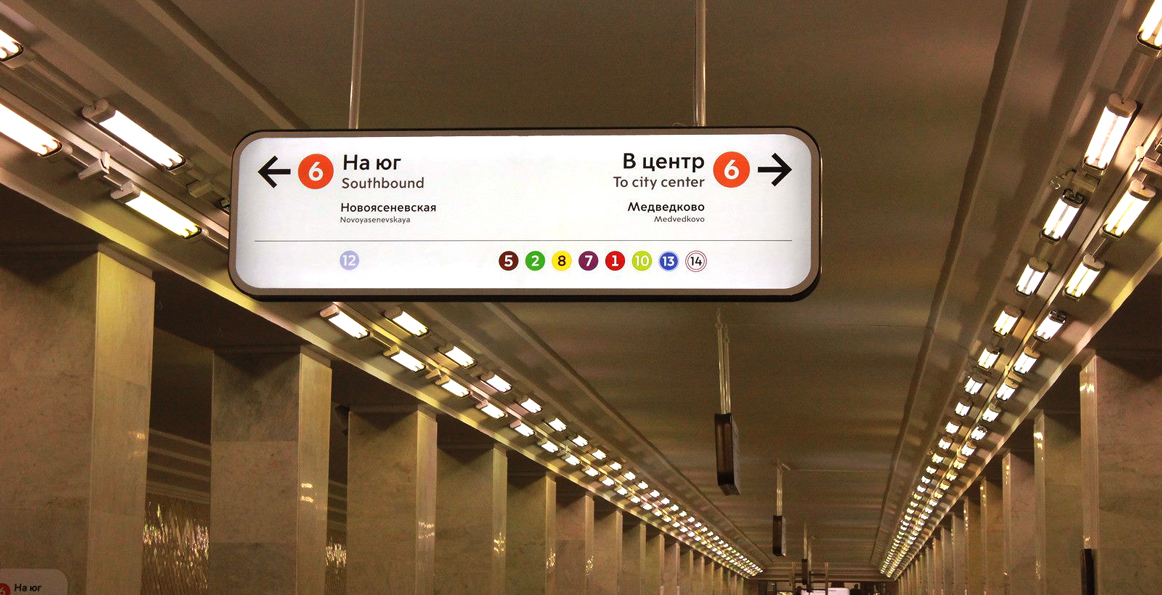
In trains, stations are announced in Russian and English. In newer trains there are also visual indication of there you are on the line.
To change lines look for these signs. This one shows the way to line 2.
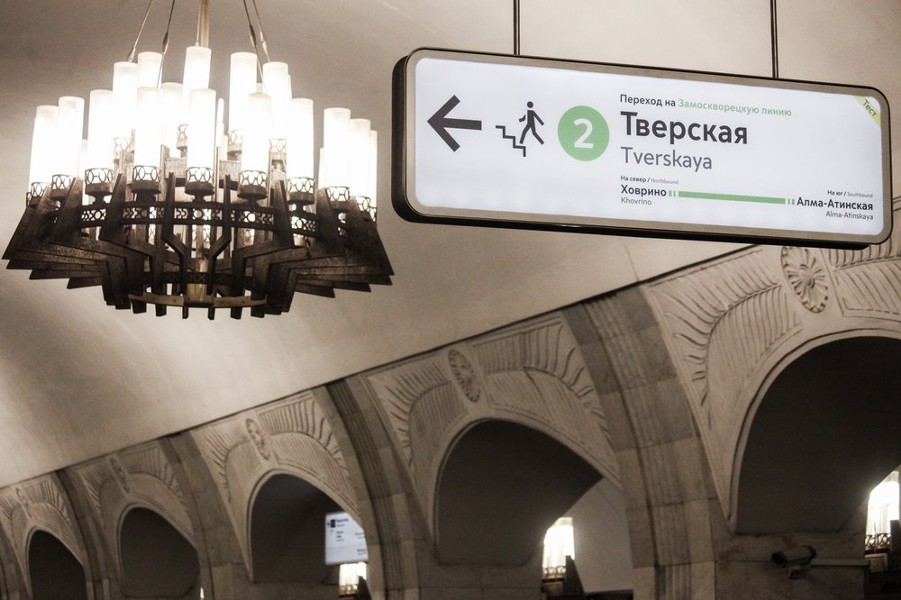
There are also signs on the platfrom. They will help you to havigate yourself. (To the lines 3 and 5 in this case).


IMAGES
VIDEO
COMMENTS
William LaTour, better known by his stage names LaTour and Bud LaTour, is an American musician, disc jockey and voice-over artist.His musical genres span electronic, house, glam, rock, dance, punk, and parody. LaTour is best known for the 1991 Number 1 Billboard electronic dance hit "People Are Still Having Sex". and for his instrumental deep house track, "Blue".
Jean-Joseph de Mondonville, by Maurice Quentin de La Tour, ca. 1746. Jean-Joseph de Mondonville (French pronunciation: [ʒɑ̃ ʒozɛf də mɔ̃dɔ̃vil], 25 December 1711 (baptised) - 8 October 1772), also known as Jean-Joseph Cassanéa de Mondonville, was a French violinist and composer.He was a younger contemporary of Jean-Philippe Rameau and enjoyed great success in his day.
Georges De la TOUR - le songe de Joseph 1640L'enfant surgit de la nuit, debout, la main gauche ouverte vers le ciel. Son bras droit est tendu vers le vieilla...
Summary of Georges de La Tour. One of the greatest exponents of 17 th century Baroque painting, La Tour's mastery of chiaroscuro was such that he is often named as Caravaggio's natural successor. But La Tour's paintings, although relatively small in number, stand on their own terms for an economy of styling that charge his brooding candlelit scenes with a sense of enigmatic tranquility.
Cantante is the Italian expression that the Volturi use to describe a human whose blood particularly appeals to a certain vampire in an extreme sense. "Cantante" is the Italian word for "singer", denoting when the blood of the human sings for the vampire."La tua" is Italian for "your"; completing the english translation as "your singer".The smell of each human is different, and certain humans ...
The Penitent Magdalen. Georges de La Tour French. ca. 1640. On view at The Met Fifth Avenue in Gallery 622. With its extreme contrasts of candlelight and shadow, pared-down geometry, and meditative mood, this painting exemplifies La Tour's painting at its most accomplished and characteristic. These visual qualities were a powerful ...
The Fortune Teller is an oil painting of circa 1630 by the French artist Georges de La Tour.The work was uncovered in about 1960 and purchased that year by the Metropolitan Museum of Art in New York. François Georges Pariset described the painting in The Metropolitan Museum of Art Bulletin, attributing it to La Tour—a likely choice given the calligraphic signature at top right: "G. de La ...
Chateau La Tour Carnet is now one of the largest vineyards in Bordeaux and they are also one of the top producers in the Haut Medoc appellation area today.. Chateau La Tour Carnet Vineyards, Terroir, Grapes, Winemaking The massive 190 hectare Left Bank vineyard of La Tour Carnet is the largest of all of the 1855 Classified Growths. The vines are well placed in the Haut Medoc appellation.
Georges de La Tour (born March 19, 1593, Vic-sur-Seille, Lorraine, France—died Jan. 30, 1652, Lunéville) was a painter, mostly of candlelit subjects, who was well known in his own time but then forgotten until well into the 20th century, when the identification of many formerly misattributed works established his modern reputation as a giant of French painting.
Meaning and Interpretation. "Cantate Domino" is a song of praise and thanksgiving. It celebrates the wonders and miracles performed by God and acknowledges His righteousness and mercy. The lyrics speak of salvation and redemption, inviting all the people of the earth to rejoice in the presence of the Lord and to offer Him their songs of ...
Chateau La Tour Carnet 2019 from Haut Medoc, Bordeaux, France - Blend: 50% Cabernet Sauvignon, 50% MerlotThe Barrel Sample for this wine is under 14% ABV....
La renombrada cantante mexicana, te hará vibrar con sus más grandes éxitos en una noche llena de recuerdos. El boleto VIP incluye: 1 gran asiento (tercera fila) y la oportunidad de conocer y saludar antes del espectáculo. Yuri arrives in Nashville for the first time with her Euphoria Tour. The renowned Mexican singer will make you vibrate ...
Tour Cantate. Name of Complex. A complex is a group of buildings which are designed and built as pieces of a greater development. Les Orgues de Flandre. Type. CTBUH collects data on two major types of tall structures: 'Buildings' and 'Telecommunications / Observation Towers.' A 'Building' is a structure where at least 50% of the height is ...
La Tour Cafe Kapolei. Order Online Uber Eats 4450 Kapolei Pkwy #530. Kapolei, HI 96707. Hours Daily 10am-8pm. Phone (808) 888-2220. La Tour Cafe Aina Haina. Order Online 820 W. Hind Dr #1291. Honolulu, HI 96821. Hours Daily 10am-8pm. Phone (808) 373-5174. Company Information. About Us. Careers.
Cantate Domino canticum novum quia miserabilia, Grand motet Alt ernative. Title Composer Lalande, Michel Richard de: Opus/Catalogue Number Op./Cat. No. S.72 I-Catalogue Number I-Cat. No. IML 9 Year/Date of Composition Y/D of Comp. 1707 Librettist Psalm 97 Language Latin Composer Time Period Comp. Period: Baroque: Piece Style Baroque ...
A vendre un appartement de 4 pièces de 85 m2 rue Archereau dans le 19eme arrondissement à Paris, proche du métro Riquet(ligne 7), dans la tour Cantate, au 2eme étage avec ascenseur comprenant: une entrée, une cuisine séparée avec cellier, une salle à manger donnant sur un balcon, 3 chambres, une salle de bains, un dressing, un wc séparé.
40 Facts About Elektrostal. Elektrostal is a vibrant city located in the Moscow Oblast region of Russia. With a rich history, stunning architecture, and a thriving community, Elektrostal is a city that has much to offer. Whether you are a history buff, nature enthusiast, or simply curious about different cultures, Elektrostal is sure to ...
La Tour is a supplier of flavorings, natural extracts, dehydrated products, encapsulated ingredients and fragrances, with a history of more than sixty-five years as a manufacturer; we serve the national and international markets from our two operation centers located in Cali, Colombia. We have modern facilities and state-of-the-art technology ...
Explore La Tour Cafe's menu of sandwiches, salads, soups, and desserts. Order online or visit one of their locations in Hawaii.
La Tour is a supplier of flavors, natural extracts, dehydrated products, encapsulated ingredients and fragrances, with a history of more than sixty-five years as a manufacturer; we serve the national and international markets from our two operation centers located in Cali, Colombia.
6. Novoslobodskaya Metro Station was built in 1952. It has 32 stained glass murals with brass borders. Novoslobodskaya metro station. 7. Kurskaya Metro Station was one of the first few to be built in Moscow in 1938. It has ceiling panels and artwork showing Soviet leadership, Soviet lifestyle and political power.
The Moscow Metro Tour is included in most guided tours' itineraries. Opened in 1935, under Stalin's regime, the metro was not only meant to solve transport problems, but also was hailed as "a people's palace". Every station you will see during your Moscow metro tour looks like a palace room. There are bright paintings, mosaics ...
Check your gift card balance and get your online redemption code
Will it be easy to find my way in the Moscow Metro? It is a question many visitors ask themselves before hitting the streets of the Russian capital. As metro is the main means of transport in Moscow - fast, reliable and safe - having some skills in using it will help make your visit more successful and smooth. On top of this, it is the most beautiful metro in the world!